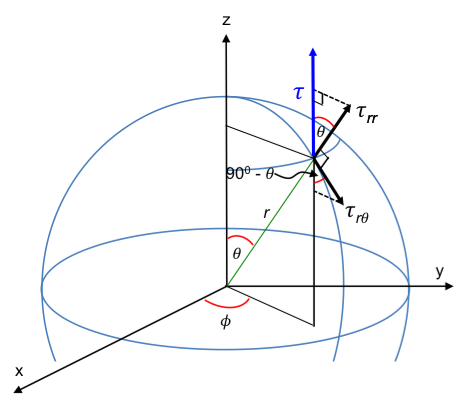The derivation of Stokes’ law involves a few steps. Firstly, we shall derive the expression . Substituting eq33b in eq33, we have:
Substituting eq35b in eq47 and working out the algebra, we get:
The gradient of a function p in spherical coordinates is . Since fluid flow is along the z-axis,
, which when compared with the above equation:
Next, we shall show that . From a previous article,
, and so,
Substituting eq44 in eq49 and working out the algebra, we have:
Substituting eq50 in the first equation of eq48 and integrating, we have:

With reference to the diagram above, the stress τ on the sphere in the z-direction is given by the sum of the projections of τrr and τrθ on the z-axis:
From the articles on constitutive relation, . So,
Question
Show that .
Answer
We need to convert the term in
, which is in Cartesian coordinates, to spherical coordinates. Let i =1 and j = 2,
In Cartesian coordinates, and
. So,
Since and
are scalars, we can rewrite the above as:
We can now replace the orthogonal Cartesian basis vectors with orthogonal spherical basis vectors in eq53c:
In spherical coordinates, and
. So, working out the algebra and using the identities
,
and
, the above equation becomes:
Substituting eq53d in eq53b completes the exercise.
Substitute eq45, eq51 and r = a (on the surface of the sphere) in eq53,
Substitute eq45, eq46 and r = a (on the surface of the sphere) in eq53a,
Substitute eq54 and eq55 in eq52,
The drag on the sphere FD is therefore the integral of the stress vector over the surface area of the sphere:
Substitute eq56 in the above integral,
Integrate by substituting x = sinθ, dx = cosθdθ, we have
where a is the radius of the sphere.
